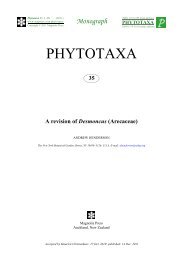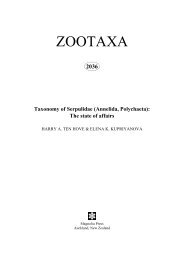You also want an ePaper? Increase the reach of your titles
YUMPU automatically turns print PDFs into web optimized ePapers that Google loves.
Orodoris Bergh, 1875, as “Nov. Gen.”; JMG 3(8) 1875b: 199 [67]. Type species by monotypy, Orodoris<br />
miamirana Bergh, 1875. Valdés & Gosliner (1999) synonymized under Ceratosoma Gray, 1850.<br />
Orodoris miamirana Bergh, 1875, as “n. sp.”; JMG 3(8) 1875b: 199–203 [67–71], 227 [95], 231 [99], pl. 7, figs. 3<br />
(multiple), pl. 10, figs. 9–20. Tahiti (Garrett, coll.). Recognized by Valdés & Gosliner (1999: 37) as Ceratosoma<br />
miamirana (Bergh, 1875).<br />
Phestilla Bergh, 1874, as “Nov. Gen.“; JMG 3(6) 1874c: 91, 114. Type species by original designation (I.C.Z.N.<br />
1999 Art. 68.2.1.), Phestilla melanobrachia Bergh, 1874.<br />
Phestilla melanobrachia Bergh, 1874, as “n. sp.”; JMG 3(6) 1874c: 91–95, 114, pl. 2, figs. 1–14. Philippines<br />
(Semper, coll.).<br />
Phyllidia loricata Bergh, 1873, as “n. sp.”; JMG 1(2) 1873a: 138 [66], 144–147 [72–75]. Tahiti (Garrett, coll.).<br />
Accepted as valid species Phyllidiopsis loricata (Bergh, 1873) by Brunckhorst (1993: 68).<br />
Phyllidia rosans Bergh, 1873, as “n. sp.”; JMG 1(2) 1873a: 138 [66], 139–144 [67–72], 165 [93], 166 [94], pl. 9,<br />
figs. 1–4; pl. 10, figs. 1–18. Tahiti (Garrett, coll.). Misspelled as P. “rosacea” in the Zoological Record (Martens<br />
1875: 153). Accepted as valid species Phyllidiopsis rosans (Bergh, 1873) by Brunckhorst (1993: 56).<br />
Plakobranchus chlorophacus Bergh, 1873, as “n. sp.”; JMG 1(2) 1873a: 148–151 [76–79], 165–167 [93–95], pl.<br />
9, figs. 5, 6; pl. 10, figs. 22–25; pl. 11, figs. 3–6. Huahine, Society Islands (Garrett, coll.).<br />
Vaginulus australis Heynemann, 1876, as “n. sp.”; JMG 5(12): 159. Queensland, Australia (Dämel, coll.). Now<br />
placed in genus Atopos, Rathouisiidae.<br />
Patronyms for collectors and other museum personnel<br />
Most of the Museum-Godeffroy contributors and other personnel were honored in patronyms by the describers of<br />
new taxa from the museum collections. Some 35 new animal and plant names were introduced for Godeffroy alone<br />
(Scheps, 2005: 59). Among molluscan taxa, we find names such as Diplommatina godeffroyana Mousson, 1870;<br />
Neritina godeffroyana Mousson, 1869; Pecten schmeltzii Kobelt in Küster & Kobelt, 1888; Navicella schmeltziana<br />
Mousson, 1870; Nanina schmeltziana Mousson, 1865; Melania lutosa Gould var. graeffei Mousson, 1869; Patula<br />
graeffei Mousson, 1869; Phasianella graeffei Dunker, 1871; Onchidium daemeli Semper, 1882; and Melania<br />
kubaryi Brot, 1886; all first appearing as nomina nuda in the Catalog series (see numbers 1116a, 1356a, 1767,<br />
3200, 3213, 3233, 6590, 6622, 14462, 14738). Other such nomina nuda intended to honor persons affliated with<br />
the museum were apparently never validated (e.g., numbers 1328, 1833a, 3315, 3334, 6308, 9370).<br />
Type specimens from the Godeffroy collection<br />
As detailed as the published Catalogs are, they do not reflect the full scale and diversity of the Godeffroy museum<br />
holdings. They merely are lists of the “duplicates” (one of the three parts of the Godeffroy collection), representing<br />
extra specimens of large original series or subsequently recollected material deemed unnecessary for the formed<br />
scientific and display collections of the museum. While they certainly can be useful in reconstructing potential type<br />
series of nominal species based on “Godeffroy” material and present the only published link to species numbers<br />
used in the organization of the collections, the specimens originally included in the two formal collections and any<br />
series potentially retained by the describing specialists also need to be considered. No comprehensive effort has<br />
been made to locate all type specimens, but individual searches for types based on specimens in the Museum<br />
Godeffroy have been reported. Ladiges (1958) described the successful search for type specimens of fishes in the<br />
Hamburg Museum collection, a quest aided by the existence of original labels and notation of collection numbers,<br />
but complicated by the fact that not all zoological collections had been transferred to the Museum, that type<br />
specimens were not specifically marked, and that the wet-preserved specimens had been lost due to deterioration in<br />
64 · Zootaxa 3511 © 2012 <strong>Magnolia</strong> <strong>Press</strong><br />
BIELER & PETIT
















